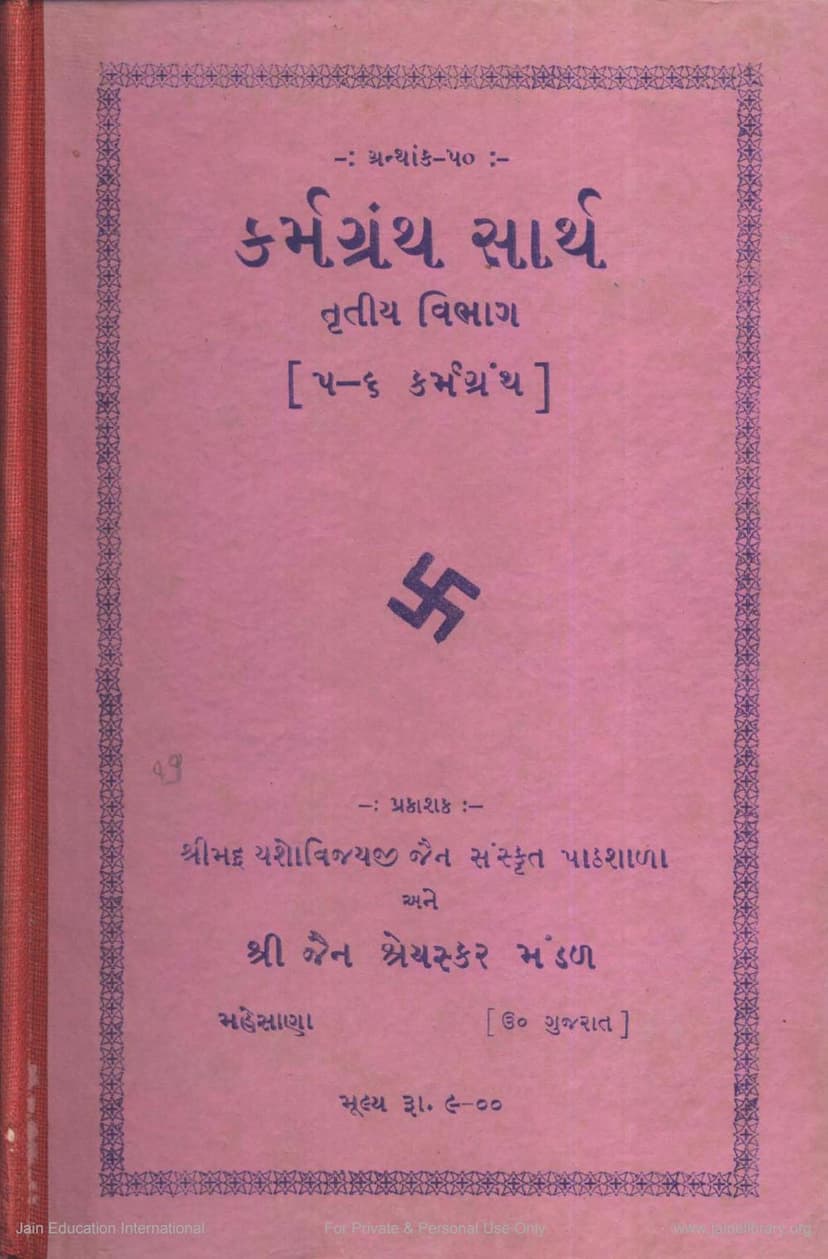Karmagrantha Part 3
Added to library: September 2, 2025

Summary
This is a comprehensive summary of "Karmagrantha Part 3" by Devendrasuri, Jivavijay, and Prabhudas Bechardas Parekh, published by Jain Shreyaskar Mandal Mahesana.
Book Title: Karmagrantha Part 3 (કર્મગ્રંથ તૃતીય વિભાગ) Author(s): Devendrasuri, Jivavijay, Prabhudas Bechardas Parekh Publisher: Jain Shreyaskar Mandal Mahesana Language: Gujarati (with Sanskrit verses)
This third part of the Karmagrantha (Book of Karma) focuses on the 5th and 6th Karmagranthas. The book aims to provide a detailed understanding of the complexities of karma according to Jain philosophy, making profound concepts accessible to a wider audience.
Key Features and Content:
- Purpose: The primary goal of this series, and specifically this volume, is to enlighten readers about the nature of karma, its bondage, its manifestations (udaya), its persistence (satta), and the means to overcome it, as expounded in Jain scriptures. The text emphasizes that liberation (moksha) is unattainable without breaking the cycle of karma.
- Structure: The book presents the 5th and 6th Karmagranthas with extensive commentary and explanations. It includes:
- Original Sanskrit Verses (Gathas): The core philosophical statements are presented in their original form.
- Word-for-word meaning (Shabdarth): Each verse's literal meaning is explained.
- Verse meaning (Gatharth): The deeper implication and essence of each verse are elucidated.
- Balbodh Commentary by Muni Shri Jivavijayji: This is a crucial element, offering a simplified and pedagogical explanation of the complex concepts, making them understandable for students and lay followers.
- Footnotes and Appendices: These provide further clarification, context, and details, especially on specific concepts like the places of bondage, manifestation, and persistence of karma, and the nature of 'Namkarma' (name-creating karma) in different life-forms and states.
- Content Focus (5th Karmagranth - Shataknama - Hundred Names):
- The 5th Karmagranth is structured around 12 main topics related to karma, covering:
- Dhruva Bandhi (permanently bound) and Adhruva Bandhi (non-permanently bound) natures of karmas.
- Dhruva Udayi (permanently manifesting) and Adhruva Udayi (non-permanently manifesting) natures.
- Dhruva Satta (permanently existing in the soul) and Adhruva Satta (non-permanently existing).
- Ghati (destroying) and Aghati (non-destroying) karmas.
- The categories of Punya (meritorious) and Paap (demeritorious) karmas.
- Vipak (manifestation/result) as Kshetra-vipaki (location-specific), Jiva-vipaki (soul-specific), Bhava-vipaki (state-specific), and Pudgala-vipaki (matter-specific).
- The four types of bondage: Prakriti-bandh (nature of bondage), Sthiti-bandh (duration of bondage), Ras-bandh (intensity of bondage), and Pradesh-bandh (quantity of karmic particles).
- The concept of 'Ch' which encompasses Upasham Shreni (stage of subsidence) and Kshay Shreni (stage of destruction).
- The text meticulously details which karmas fall into which categories (Dhruva Bandhi, Adhruva Bandhi, etc.) and provides a breakdown of these classifications with specific examples of karmic permutations.
- It elaborates on the "Ghati" (destroying) karmas (Jnanavarniya, Darshanavarniya, Mohaniya, Antaray) and "Aghati" (non-destroying) karmas (Nam, Gotra, Vedaniya, Ayushya).
- A significant portion delves into the durations (Sthiti Bandh) and intensities (Ras Bandh) of various karmas, often expressed in cosmic time scales like Sagaropam and Palopam.
- It analyzes the 'Bhangas' (permutations or modes) of bondage, manifestation, and persistence for different karmas across various states of existence and spiritual progress (Gunasthans).
- The 5th Karmagranth is structured around 12 main topics related to karma, covering:
- Content Focus (6th Karmagranth - Saptatika - Seventy Names):
- The 6th Karmagranth focuses on the classification and analysis of karmas based on their seventy primary characteristics.
- It further categorizes karmas based on their existence in different Jiva Sthanas (states of souls) and Gunasthanas (stages of spiritual progress).
- The text details the complex interrelationships between different karmic permutations, their bondage, manifestation, persistence, and the specific soul states and spiritual stages involved.
- It elaborates on the 'Bhangas' (permutations or modes of karmic activity) for Mohaniya Karma (delusion karma) in detail, analyzing how different karmic states arise in various soul conditions.
- The text provides elaborate tables (Yantras) that summarize the vast permutations of karmic manifestations across different soul categories (Jiva-bhed), spiritual stages (Gunasthana), and activities (Yoga, Leshya, etc.). These tables are crucial for understanding the intricate workings of karma.
Key Concepts Explained:
- Bandha (Bondage): How karmic particles attach to the soul.
- Udaya (Manifestation): How karmas fructify and influence the soul's experiences.
- Satta (Persistence): How karmas remain in a dormant state within the soul, awaiting manifestation.
- Prakriti (Nature): The specific types of karmas (e.g., Jnanavarniya, Mohaniya).
- Sthiti (Duration): The lifespan of karmic bondage.
- Ras (Intensity/Taste): The quality and impact of the karmic result.
- Pradesh (Quantity): The number of karmic particles that bind.
- Bhanga (Permutations): The various ways karmic activities can occur, considering different conditions.
- Gati (States of Existence): Naraka (hellish), Tiriyancha (sub-human), Manushya (human), and Deva (celestial).
- Gunasthana (Stages of Spiritual Progress): The 14 stages of spiritual development from Mithyatva (utter delusion) to Siddha (liberated soul).
- Upasham Shreni (Stage of Subsidence): A process of pacifying karmic energies.
- Kshay Shreni (Stage of Destruction): A process of eradicating karmic energies.
Significance:
The Karmagrantha series, and this volume in particular, is a foundational text for understanding the intricate Jain doctrine of karma. The "Balbodh" commentary makes this complex subject accessible, facilitating deeper spiritual study and practice for practitioners. The detailed analysis of permutations and the inclusion of summary tables (Yantras) are invaluable for scholars and serious students of Jainism. The publishers, Jain Shreyaskar Mandal Mahesana, and the Sanskrit Pathshala, have made significant efforts to present this knowledge in a clear and comprehensive manner.
Overall Impression:
Karmagrantha Part 3 is a scholarly yet accessible work that systematically unravels the complex workings of karma in Jainism. It serves as an essential guide for anyone seeking to understand the spiritual path as laid out in the Agamas, emphasizing the causal relationship between actions, karmic bondage, and the ultimate goal of liberation. The dedication to providing detailed explanations, commentaries, and summaries through various Yantras highlights the commitment to making this profound knowledge available.